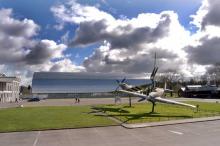Generation 6 Technology to Protect RAF Museum in London
Generation 6 Technology to Protect RAF Museum in London
The digital system will provide the highest levels of protection for the museum, helping to significantly reduce maintenance, which given the sheer size and nature of the site – is extremely difficult to complete.
The Royal Air Force Museum is Britain’s only national museum dedicated wholly to aviation. With a world-class aircraft collection, integrated with special exhibitions, films, interactives, artwork, engines, missiles, photographs, uniforms, medals and research and education facilities, the museum takes an innovative approach while keeping with tradition. The London site is situated on what used to be RAF Hendon and holds over 100 aircraft in five themed aircraft halls.
The existing fire alarm system at the Royal Airforce Museum was originally installed in 1992, but as technology has progressed, the analogue fire alarm system needed to be upgraded. As such ADT Fire & Security was appointed to undertake the upgrade building by building, replacing the outdated system with the new, robust, digital system.
Generation 6 Technology, based on ADT Fire & Security’s established MZX Technology platform, provides superior detection performance, greater fault tolerance and improved environmental protection. Furthermore, the system features a remote wireless link built into the device housing, which enables two-way communication with the 850EMT Engineering Management Tool. This allows the ADT engineers at the RAF Museum to adjust the settings and parameters of detectors without having to manually access each detector. For the RAF Museum, which requires a large quantity of detectors and where access is an issue, this offers significant time savings.
As part of the upgrade, we will incorporate a VESDA Aspirating Smoke Detection system in three of our buildings, including the Bomber Command Hall,” explained Mike Gell, Buildings and Services Manager for the RAF Museum. “This uses air sampling technology to detect fires at a very early stage as the fast detection of a fire is absolutely crucial to safeguard the exhibits. In addition, given that the Bomber Command Hall and other buildings are extremely large with high roof spaces, some with suspended aircraft, there’s simply no way to quickly or easily access detectors. So utilising the VESDA system, which allows us to access one central box was a great advantage.”
The upgrade at the RAF Museum is expected to be completed over a two-month period and will ensure that the site benefits from a modern, digital system that provides faster and more advanced fire alarm technology critical for a large site.
For further information please visit: www.adt.co.uk

